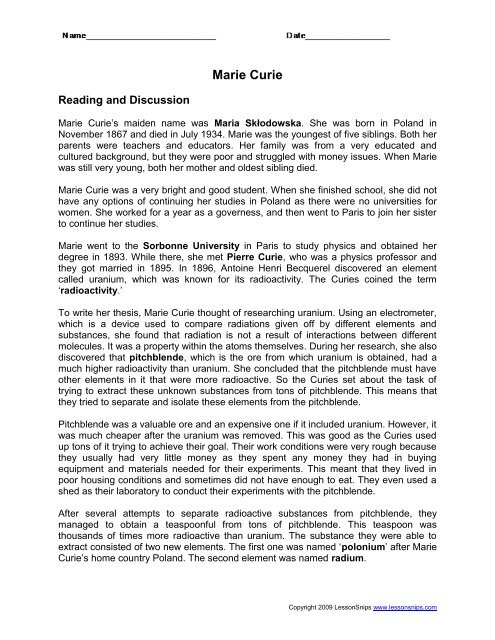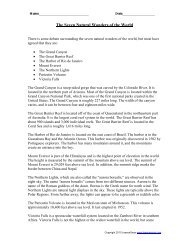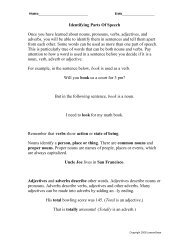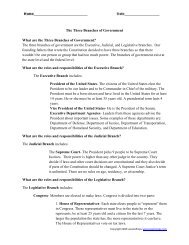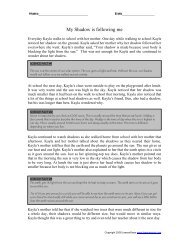Marie Curie - LessonSnips
Marie Curie - LessonSnips
Marie Curie - LessonSnips
Create successful ePaper yourself
Turn your PDF publications into a flip-book with our unique Google optimized e-Paper software.
<strong>Marie</strong> <strong>Curie</strong><br />
Reading and Discussion<br />
<strong>Marie</strong> <strong>Curie</strong>’s maiden name was Maria Skłodowska. She was born in Poland in<br />
November 1867 and died in July 1934. <strong>Marie</strong> was the youngest of five siblings. Both her<br />
parents were teachers and educators. Her family was from a very educated and<br />
cultured background, but they were poor and struggled with money issues. When <strong>Marie</strong><br />
was still very young, both her mother and oldest sibling died.<br />
<strong>Marie</strong> <strong>Curie</strong> was a very bright and good student. When she finished school, she did not<br />
have any options of continuing her studies in Poland as there were no universities for<br />
women. She worked for a year as a governess, and then went to Paris to join her sister<br />
to continue her studies.<br />
<strong>Marie</strong> went to the Sorbonne University in Paris to study physics and obtained her<br />
degree in 1893. While there, she met Pierre <strong>Curie</strong>, who was a physics professor and<br />
they got married in 1895. In 1896, Antoine Henri Becquerel discovered an element<br />
called uranium, which was known for its radioactivity. The <strong>Curie</strong>s coined the term<br />
‘radioactivity.’<br />
To write her thesis, <strong>Marie</strong> <strong>Curie</strong> thought of researching uranium. Using an electrometer,<br />
which is a device used to compare radiations given off by different elements and<br />
substances, she found that radiation is not a result of interactions between different<br />
molecules. It was a property within the atoms themselves. During her research, she also<br />
discovered that pitchblende, which is the ore from which uranium is obtained, had a<br />
much higher radioactivity than uranium. She concluded that the pitchblende must have<br />
other elements in it that were more radioactive. So the <strong>Curie</strong>s set about the task of<br />
trying to extract these unknown substances from tons of pitchblende. This means that<br />
they tried to separate and isolate these elements from the pitchblende.<br />
Pitchblende was a valuable ore and an expensive one if it included uranium. However, it<br />
was much cheaper after the uranium was removed. This was good as the <strong>Curie</strong>s used<br />
up tons of it trying to achieve their goal. Their work conditions were very rough because<br />
they usually had very little money as they spent any money they had in buying<br />
equipment and materials needed for their experiments. This meant that they lived in<br />
poor housing conditions and sometimes did not have enough to eat. They even used a<br />
shed as their laboratory to conduct their experiments with the pitchblende.<br />
After several attempts to separate radioactive substances from pitchblende, they<br />
managed to obtain a teaspoonful from tons of pitchblende. This teaspoon was<br />
thousands of times more radioactive than uranium. The substance they were able to<br />
extract consisted of two new elements. The first one was named ‘polonium’ after <strong>Marie</strong><br />
<strong>Curie</strong>’s home country Poland. The second element was named radium.<br />
Copyright 2009 <strong>LessonSnips</strong> www.lessonsnips.com
Though they succeeded in their experiment in 1898, it took until 1910 for Madame <strong>Curie</strong><br />
to be able to get radium in its pure state. The <strong>Curie</strong>s also studied the radiations from<br />
radium as well as the effect of magnetism on radiations. This is considered to be the<br />
groundwork for research in nuclear physics.<br />
The <strong>Curie</strong>s had two daughters, Irene and Eve. In 1906, Pierre <strong>Curie</strong> died in a street<br />
accident. In 1903, they shared the Nobel Prize with Becquerel for Physics. Madame<br />
<strong>Curie</strong> continued her research and was awarded another Nobel Prize for Chemistry in<br />
1911. This made her the first scientist to receive two Nobel Prizes and the first woman<br />
scientist to ever receive a Nobel Prize. She was also the first woman professor at the<br />
Sorbonne University and the first woman to chair the physics department.<br />
During World War I, Madame <strong>Curie</strong> supported the use of x-ray machines to help injured<br />
soldiers. She also donated the gold Nobel Prize medals that she and her husband had<br />
received to help the soldiers.<br />
At the time, the dangers of radioactive elements was unknown, so there were no proper<br />
measures taken to handle these elements. Until this day, <strong>Marie</strong> <strong>Curie</strong>’s notebooks and<br />
even cookbook cannot be touched or handled without wearing the proper protective<br />
gear. Madame <strong>Curie</strong> became ill from a blood disease most probably caused by<br />
radioactivity.<br />
To honor the hard work and years of contribution of the <strong>Curie</strong>s, a measurement unit of<br />
radioactivity was named <strong>Curie</strong>. In addition, an element called curium was also named<br />
after them.<br />
Copyright 2009 <strong>LessonSnips</strong> www.lessonsnips.com
Activities<br />
Activity A: Multiple Choice:<br />
1. <strong>Marie</strong> <strong>Curie</strong> was all of the following except:<br />
a. Physicist<br />
b. Chemist<br />
c. Professor<br />
d. Engineer<br />
2. The element discovered called ‘polonium’ was named as such because:<br />
a. It honored <strong>Marie</strong> <strong>Curie</strong>’s home country Poland<br />
b. It rhymed with uranium<br />
c. It was random<br />
d. None of the above<br />
3. From pitchblende, <strong>Marie</strong> <strong>Curie</strong> was able to extract and isolate:<br />
a. Uranium<br />
b. Sodium<br />
c. Radium<br />
d. All of the above<br />
Activity B: List three things <strong>Marie</strong> <strong>Curie</strong> was considered the first woman to achieve:<br />
1. ______________________ ______________________________<br />
2. _____________________________ _______________________<br />
3. _____________________________________________________<br />
Activity C: True or False:<br />
____ 1. <strong>Marie</strong> <strong>Curie</strong> discovered an element called uranium.<br />
____ 2. <strong>Marie</strong> <strong>Curie</strong> discovered that pitchblende had more radioactivity than uranium.<br />
____ 3. <strong>Marie</strong> <strong>Curie</strong> refused to donate the gold medals that she and her husband Pierre<br />
had been awarded for winning the Nobel Prize during World War I.<br />
____ 4. At the time, <strong>Marie</strong> and Pierre <strong>Curie</strong> understood how radioactive chemicals<br />
should be handled and wore protective gear.<br />
Copyright 2009 <strong>LessonSnips</strong> www.lessonsnips.com
Answer Key<br />
Activity A<br />
1. <strong>Marie</strong> <strong>Curie</strong> was all of the following except:<br />
a. Physicist<br />
b. Chemist<br />
c. Professor<br />
d. Engineer<br />
2. The element discovered called ‘polonium’ was named as such because:<br />
a. It honored <strong>Marie</strong> <strong>Curie</strong>’s home country Poland<br />
b. It rhymed with uranium<br />
c. It was random<br />
d. None of the above<br />
3. From pitchblende, <strong>Marie</strong> <strong>Curie</strong> was able to extract and isolate:<br />
Activity B<br />
Activity C<br />
a. Uranium<br />
b. Sodium<br />
c. Radium<br />
d. All of the above<br />
1. First woman to win a Nobel Prize____________________________<br />
2. First woman to be a professor at the Sorbonne University in Paris___<br />
3. First woman to head the chair of the Physics Department__________<br />
4. First woman to receive 2 Nobel Prizes in different fields (Physics & Chemistry)<br />
F 1. <strong>Marie</strong> <strong>Curie</strong> discovered an element called uranium.<br />
T 2. <strong>Marie</strong> <strong>Curie</strong> discovered that the pitchblende had a much higher radioactivity than<br />
uranium.<br />
F 3. <strong>Marie</strong> <strong>Curie</strong> refused to donate the gold medals that she and her husband Pierre<br />
had been awarded for winning the Nobel Prize during World War I.<br />
F 4. At the time, <strong>Marie</strong> and Pierre <strong>Curie</strong> understood how radioactive chemicals should<br />
be handled and wore protective gear.<br />
Copyright 2009 <strong>LessonSnips</strong> www.lessonsnips.com


